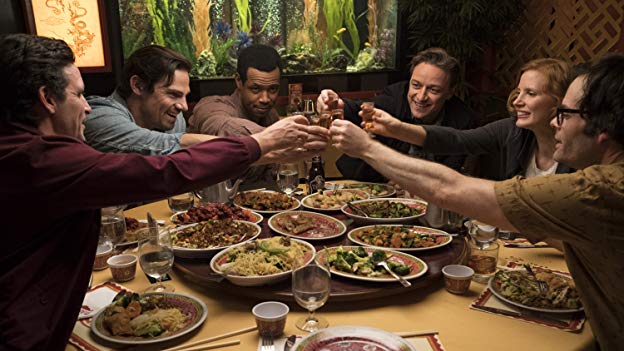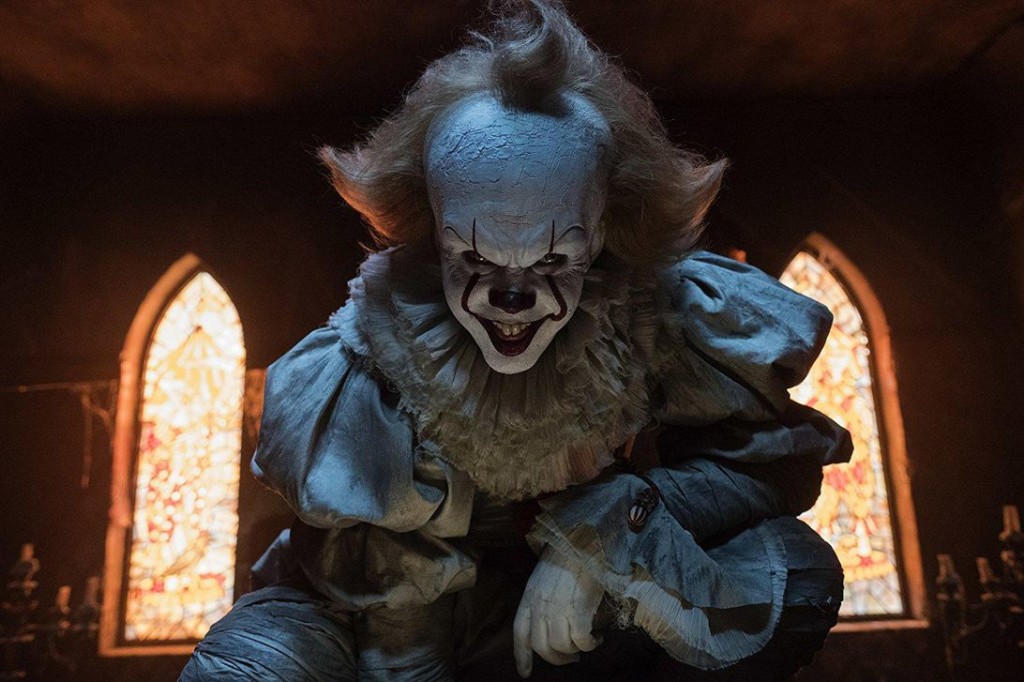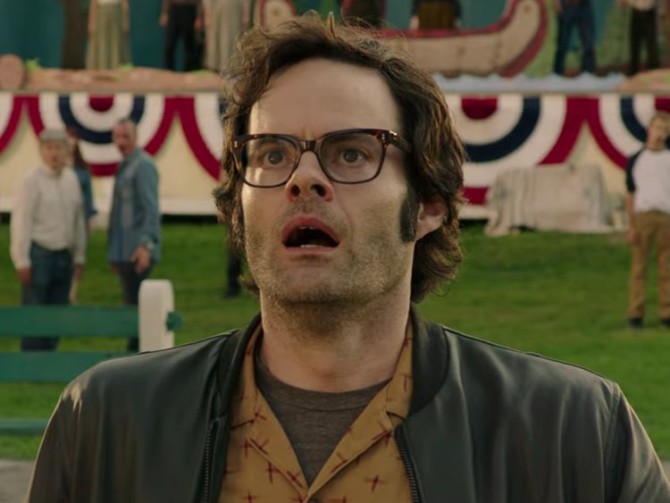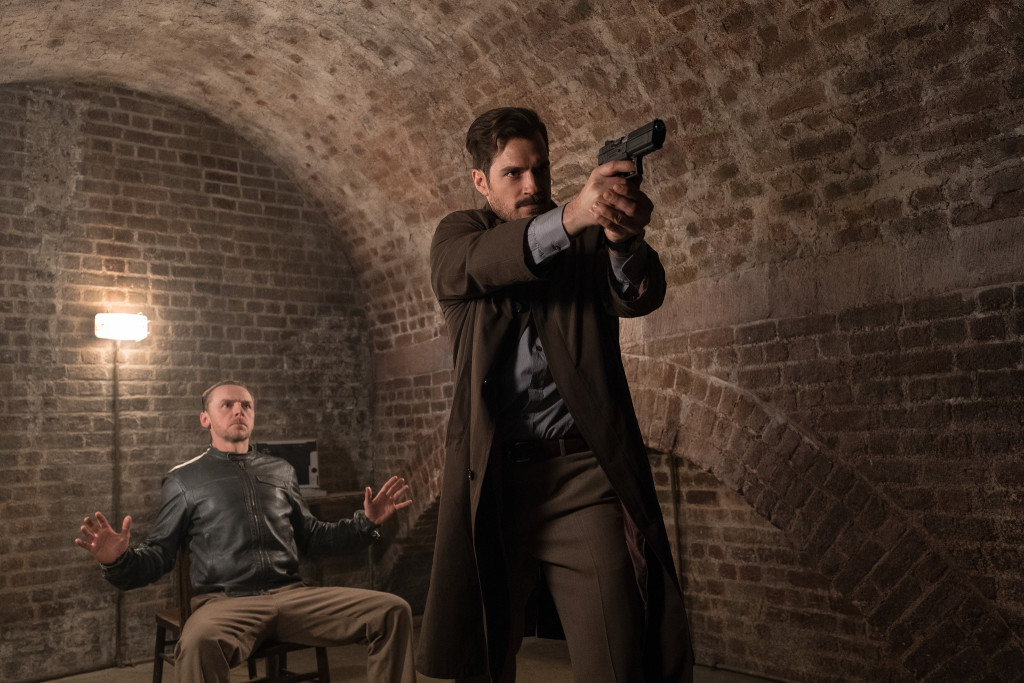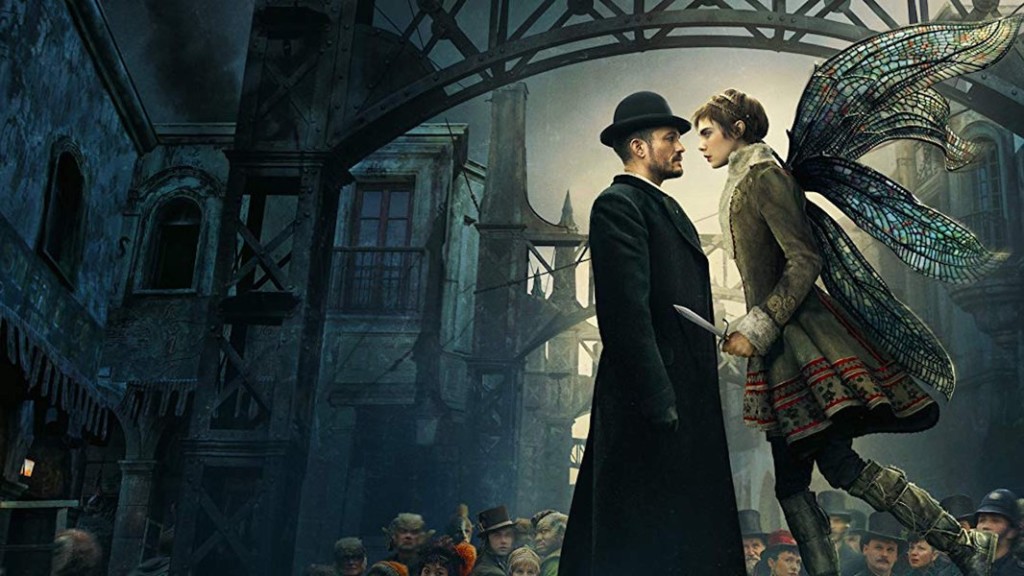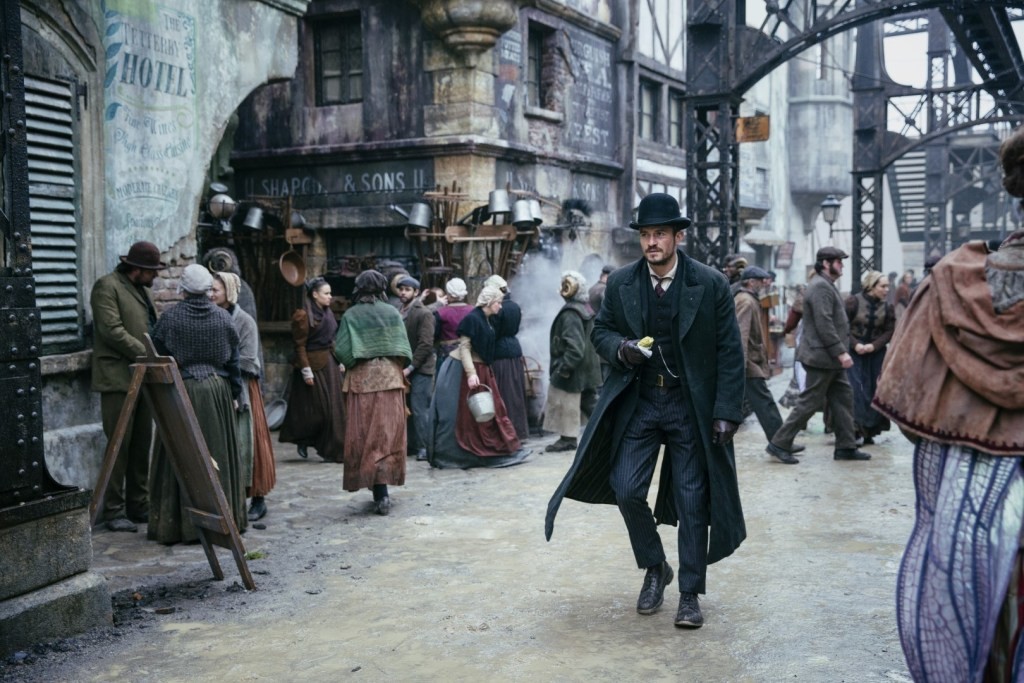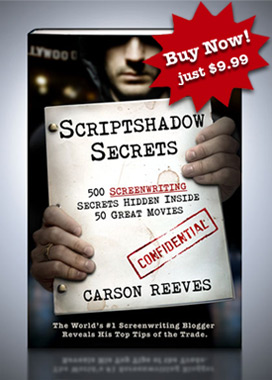Genre: Horror
Premise: The “Losers Club” comes back to their home town of Derry 27 years later to destroy the evil presence known as Pennywise, who’s returned to feast on more children.
About: It Chapter 1 became the biggest horror movie of all time, grossing 123 million domestically in its first weekend and topping off with 700 million worldwide. So the industry was a little surprised when they saw a number south of 100 million this weekend for the sequel (it grossed 91 million). It’s still a big success. But not as much of a success as everyone was hoping for. Might Carson know what the problem was? I think he might. Warner Brother’s tip-top horror scribe, Gary Dauberman, who writes all the Conjuring movies, came back to pen the It sequel.
Writer: Gary Dauberman
Details: 169 minutes
Warner Brothers is busy trying to figure out why the sequel to their monster horror hit, “It,” did 30 million less in its opening weekend than the first film. They don’t need to look far. Just type this address into your search bar: “Scriptshadow.” Because I’m about to tell them exactly what went wrong. Are you ready, WB?
No Chris Pratt.
Paying Chris Pratt 30 million dollars to play Ben Hanscom would’ve gotten you an extra 40-50 million at the box office this weekend. At the very least, it would’ve gotten you even with the last film. Instead we got someone named Jay Ryan who was the acting equivalent of an old bar of soap.
No Chris Pratt was symbolic of a bigger problem here – which was that the casting stunk. There wasn’t a single grown-up character who worked outside of Bill Hader’s Richie Tozier. The actor who played the guy who stayed behind, Mike Hanlon, was criminally dull. Whenever he spoke, I took a nap. The guy who played Eddie was only compelling in that he so closely resembled the actor who played him as a child. It was eerie. Jessica Chastain was supposed to be a slam dunk but ended up being a 20 foot jumper in a game that got out of hand in the 2nd quarter. James McAvoy brought an element of professionalism to these Elizabeth Mestnik Acting Studio rejects, but even he’s fairly vanilla here.
That left Bill Hader to do all the heavy lifting and despite trying his best, he couldn’t do it. “It” is a story more dependent on its characters and their camaraderie than 99% of the movies out there. So if the actors blow it, the movie’s doomed. And the actors blew it. Well, the director and casting director blew it cause they hired nobodies. This is a movie that needed star power. Or, at the very least, it needed proven character actors who we’ve seen before. Here are some names people were throwing out after the first film: Joseph Gordon-Levitt, Adam Scott, Mike White, Edward Norton, DJ Qualls. You can’t just throw Dipsy Dan whose last TV appearance was getting slimed on Nickelodeon 30 years ago and expect audiences to embrace it. I’m baffled by these choices. I’d go so far as to call it the biggest bungling of a cast in history.
Despite this gigantic mistake, the movie had a tiny chance to crawl back into respectability if the script was good.
Buuuuut. If you saw It: Chapter 2, you know that that script was very very very not good.
The only part of the script that possessed any structure whatsoever was the first act. And the only reason is because it was so clear what needed to happen. They had to get everyone to Derry. But once they got there, I don’t know if the writer started doing shrooms or everyone on the crew was encouraged to journal their ideas each morning and whichever entry caught director Andy Muschietti’s eye got filmed. But there were literally two and a half good scenes in the second and third acts. Which means there were over 2 hours of awful scenes. The first good scene was Jessica Chastain visiting the old woman. The second good scene was the Pennywise scene underneath the bleachers. And the half was Bill Hader taking on Paul Bunyun.
Outside of that, it was all BAAAAAAD. Really really bad messy uninspired nonsensical jibberish. To the point where I was actually angry with the director.
Let me give you some insight into screenwriting here. 99 times out of 100, when a movie is in that 2 hours and 45 minutes to 3 hour length? It represents a writer and director who have lost track of their story. They don’t know how to focus things because they don’t understand what their story is about. When you don’t understand what your story is about, you throw everything on the screen and pray that the audience does the work for you. “Maybe they’ll figure it out,” you think, even though they never do (by the way, I’m hearing Star Wars Episode 9 is going to be the same length as It: 2 — not encouraging).
This was honestly 20 horror movie shorts that I’m guessing were decided on long before they wrote the script, and the writer was given the directive to stitch them together in some desperate manner that made sense. Well, Operation FAILURE.
I sensed the script was in trouble almost immediately. Actually, I knew it was in trouble in the very first scene. Pennywise eats kids, right? That’s his thing. So why does the teaser have him killing a man? You’ve violated the main rule of your universe in the very first scene. Then you had the the kids flashbacks. Sure, they helped remind us who was who. But this movie had zero momentum. And you were choking the little momentum it had every time you flashed backwards. DON’T FLASH BACK PEOPLE! FLASHBACKS ARE ALMOST ALWAYS BAD.
The script really went into the tank when everyone bizarrely agreed to go off on their own to find their “unique artifact.” It wasn’t clear why they needed to be alone. It would’ve been a lot safer had they worked together. But NOPE – classic beginner horror screenwriter logic – shaky motivation to get the characters alone so we can have some scares.
I wish I had something good to say about this movie but I don’t have respect for films where they don’t try with the script. All they seemed to care about was the production. And make no mistake, it’s going to cost them. We don’t live in a world anymore where studios can con consumers for 3 to 4 weeks before it’s established that a movie’s bad. The consumer knows instantly now. And there’s no question had the script been better, people would’ve come out of those advanced screenings excited, which would’ve built more buzz, and you would have charged into this weekend instead of stumbled.
I finally caught another horror movie this weekend – Ma – and this film suffered from the exact same problem as It 2. Where you can really see the contrast between what these movies could’ve been and what they were is by watching their trailers. If you watched that first It: 2 trailer, it was EXTREMELY FOCUSED. It was a single scene of Jessica Chastain going to meet a creepy old woman. Yet the movie was nothing like that. It was all freaking over the place. Same thing with Ma. When you watched that trailer, it looked like a group of high school kids who take a wrong turn and get stuck in this woman’s house partying all night, and then that woman goes crazy on them. But the movie was nothing like that. They go to her house, then they go back to school, then they go to the house again the next weekend, then back to school, then they come back there and party sometimes. But sometimes they don’t…
What do I tell you guys? What is one of the precious Three Commandments in screenwriting. URGENCY. If you want instant focus? Add urgency! A huge reason why both these movies rambled was because everyone had all the time in the world! When you can just wander around town looking for scary clowns, of course things are going to get boring! You need a goal and you need that goal to come with a ticking clock. Especially when it comes to horror, which thrives on tight timelines. Just like Friday’s Amateur “worth the read” script, Grisly. They’re not going to be fighting this bear in three weeks. If they were, we would’ve checked out. They’re fighting it tonight. And only one side is getting out alive.
Man, where do we go from here? I think they’re going to try and make more sequels to this movie. But I hope not. You had such a great memory with the original film. This already taints it. I would leave this property be.
[ ] What the hell did I just watch?
[x] wasn’t for me
[ ] worth the price of admission
[ ] impressive
[ ] genius
What I learned: It’s one of the most basic components of a strong story: Focus. And yet time and time again, screenwriters abandon it. I don’t understand. Start with a goal. Add a little urgency. Make sure the stakes are high and clear. Your script will be focused. Start with 7 people. Have them sort of remember their childhood but sort of not. Tell them they have to each get an artifact because the guy who stayed home did a lot of studying and he thinks that’s important, spend the next 2 hours writing disconnected short horror films, spend an hour wandering around a cave – that’s not focus. And that’s why this movie was a disaster.
Might we have another highly reviewed amateur script on Scriptshadow? Read today’s review to find out!
Genre: Thriller
Premise: Trapped in a secluded cabin, a hunter and his daughter fend off attacks from a relentless grizzly bear hell-bent on vengeance for the death of its cub at their hands.
Why You Should Read: I vividly remember the sensation of being stalked by a black bear during one summer visit to the Sierras… Well, stalked is a bit strong – it passed me within grabbing distance. Still, the feeling of power in its gait, the potential explosion of ferocity if it so pleased was unsettling and stuck with me ever since.
Writer: Walon Costello
Details: 84 pages (just to be clear, that this is an UPDATED draft from last week. Walon addressed some of your notes)
I’ve got one question.
Did Walon write this script in one day?
Because Wednesday I reviewed a nature thriller and all I talked about was how a lack of character development hurt the script. I read a nature thriller today and… IT’S ALL CHARACTER DEVELOPMENT. So either Walon read my complaints and wrote this in a day, or he has the ability to freeze time so that he can take as long as he wants to write a script.
I bet you’re wondering what all that character development did. Would it prove that I was right? Or would it turn out that all character development does is slow down a script to an unbearable crawl? Read on to find out!
Our teaser opens with a deer being chased through the woods by something unseen. Then, just as it makes it to a clearing, it’s SMASHED INTO by a car, which goes careening off the road. The driver, a man, is instantly killed. The woman in the passenger seat is going to wish her death was that quick. Because seconds later, a little bear cub comes in and starts nibbling on her dead boyfriend. Then, seconds after that, a much bigger mama bear arrives. And this woman turns into her lunch.
Cut to a week later and Hank (40) along with his daughter, Zoe (20), are driving through those same woods. They make it to an old gas station, where the car from the teaser is being kept until someone can come along and trash it. It’s here where we learn that that car and the people who were in it are the reason Hank and Zoe are here. The woman is Hank’s drug addict ex-wife, and Zoe’s mother. Since she wasn’t found in the wreckage, they’ve come up here to look for her.
The two head up to the family’s cabin which the mom was staying at. This once regal camping fortress is now a barely standing rotted-out piece of garbage. Hank and Zoe use it as a home base to go out and look for mom. They arm themselves just in case, and after a long search, Zoe notices something coming at her out of the corner of her eye, turns and shoots. She’s horrified to see that she’s killed a baby cub.
They get back to the cabin late and decide to stay for the night. But almost immediately, they hear something outside. It’s Mama bear (“Mama”). She’s come to get revenge. At first, Hank doesn’t give her any credit. She’s a freaking bear. Not John Wick. And even if she was the bear version of John Wick, she can’t break into a house. Well, that may be true. But remember, this isn’t exactly Fort Knox. And Mama starts prying for ways in.
Having left the only guns in the car, the two are forced to move around the cabin to stay clear of Mama, who has the added advantage of being a black bear in total darkness. We’re never quite sure where she’s going to pop up next. Finally, she’s able to get into the house. Zoe moves to the bathroom while the injured Hank finds another spot to hide. I don’t want to spoil anything but let me put it this way. Not everyone is getting out of this house alive.
First thoughts?
Overwritten first page!
I kept having to go back and read it over and over again. Walon was trying to be too cute with the wording. It may sound weird but he was TOO DESCRIPTIVE. And in trying to paint a picture, he painted a Picasso. It was angular and tilted and hard to make out what you were looking at.
So things didn’t start well.
However, once we get to Hank and Zoe, the script gets a lot better. Like I said, Wednesday we had no character development. Here, we have a lot. There’s a ton going on with these two. For starters, their wife/mother left them, became a drug addict/prostitute, and now drives around and robs people to feed her habit, along with whatever co-conspirator she can find.
This makes their search party complicated. Lesser writers would’ve had the mom be the perfect mother – her life robbed by the randomness of some angry animal. By making her a drug addict who’d abandoned her family, their connection with her is much messier. The reason why this tends to work better is because it mirrors real life. Real life is rarely drawn with straight lines. The lines are squiggly. And the color between them is gray. Just that choice alone made this feel authentic.
Also, Zoe is newly pregnant. And one of the ongoing themes here is the idea of, should Hank and his wife have had Zoe? They were way too young. They weren’t ready to be adults. And it turns out that maybe it was a mistake. Mom eventually prioritized getting high over parenting. We also learn that it was Hank who initially wanted the abortion. And now Zoe’s in the exact same spot they were, weighing whether she’s ready to be a mom, and using her own less-than-wonderful time on earth to decide if she wants her own kid to go through that hell.
In other words, THERE’S A LOT GOING ON HERE. And Walon is really clever in how he thematically connects their family troubles to the threat. Here these people are, weighing whether it’s right for their children to even be born, while Mother Bear will stop at nothing to avenge the death of her own child.
Another thing I liked that Walon did was he OPENED UP a portion of the CONTAINED THRILLER. I think that when we write contained thrillers, we get this idea that they have to be contained from start to finish, if only to convey to producers that it will be cheap to make. However, I like when contained thriller writers start their scripts OPENED UP so as to create the illusion of a bigger story. Between the teaser and seeing these two drive in and the gas station scene – it made the movie feel bigger than it was. Had Walon started this script with the two of them showing up at the cabin, I’m not sure I would’ve felt the same way about the script.
There were a couple of things I didn’t love. The script does get a little repetitive at times inside the cabin. There are only so many ways to stay away from a window. But the biggest issue was that dad and daughter don’t have anything unresolved with one another. Despite all of the intense stuff with mom, Hank and Zoe seem to be good. And I kept wondering if that could’ve been improved somehow. In fact, a couple of times I thought, “I wonder if this would be better if Zoe was trapped in here with her drug-addict mom who’d abandoned her?” You can imagine how much more tense those conversations would be.
Despite that, I thought this was a good spec. The best Amateur Friday script this year behind Cop Cam. I could easily see this pitched as “Jaws with a bear.” The problem with all the Jaws clones over the years is that they’re too similar to Jaws. This feels just enough like its own thing that you don’t find yourself constantly comparing it to that movie, which is the last thing you want to happen as a writer. You want your script to be your own, not some lesser version of a better movie.
I battled back and forth on this as far as whether to give it a single or double ‘worth the read,’ and I’m going to settle on a single because dad and daughter didn’t have anything to resolve with one another. And it wasn’t just that. It was that Walon was trying to make it seem like they were butting heads despite the fact that there wasn’t any reason to. For example, she kept calling him “Hank” instead of “Dad.” And all I thought was, “Wait, she likes her dad. Why avoid that title when addressing him?” If future drafts would address that, I could easily see bumping up the score.
But this was solid writing. Good job, Walon.
Script link (new draft): Grisly
[ ] What the hell did I just read?
[ ] wasn’t for me
[x] worth the read
[ ] impressive
[ ] genius
What I learned: Regarding the first page. Remember, all writers overwrite. But the good ones don’t make it LOOK like they overwrote.
A big complaint I had with yesterday’s script was that the character writing was too thin. The extent of the character work was that the main character was grieving the loss of their father. On the surface that sounds like a deep issue to explore. A family death is a tragic experience for most people. But that’s only if you actually explore it. If it’s something mentioned at the beginning of the script and then it never comes into play again, that’s not good character development. To be clear: If nothing “develops” then it’s not character “development.”
I received an interesting response in the comments section pointing out that in these quick thriller and action scripts, you don’t have time to develop characters. I’ve heard this argument quite a bit. And the people who use it actually go one step further. It’s not just that you don’t have time, they argue, but the audience isn’t interested in character development in movies like this. They just want to see volcanoes impale people. Or John Wick throw ninja stars at the bad guys. I understand what they’re saying because it’s partly true. People go to dramas to see character exploration. They go to action movies to see action.
But what they’re forgetting is that the degree to which your audience connects to your characters is the same degree to which they care during the action scenes. Have you ever watched the most amazing big budget action scene ever and yet been totally bored? Chances are, it’s because you felt nothing for the characters involved. Have you ever watched a garden variety action scene and been riveted? Chances are you felt a closeness to the characters akin to the way you feel around your best friends. The only difference between those two scenarios is character development. The writer is doing something with the characters that’s making you feel a greater connection to them.
So where did this “no country for character development in action” rumor begin? I suspect it comes from franchises like Mission Impossible, James Bond, and Fast and Furious. Because, yeah, there isn’t a lot of character development in those films. But that’s because those characters stopped changing a long time ago. These days they’re more like old friends who come around every once in awhile to catch up. This creates the false impression that, well, those characters aren’t changing, so mine don’t need to change either.
And they don’t. There’s no rule that says your character HAS TO DEVELOP. But if you want to create more of a connection between your audience and your story, character development is the bridge that’s going to take you there.
But what is character development? Why do people have such a tough time boiling it down? I don’t know and I don’t care. Because what I’m about to do is tell you the secret to great character development. Are you ready? Here it is: There are two stories going on. The story in your movie and the story in your character. In other words, your character IS A STORY UNTO HIMSELF. Once you internalize that, your character writing is going to increase a hundred-fold.
That’s because you’re not just trying to move your plot from point A to point Z. You’re moving the story within your character from point A to point Z as well. So let’s take a very simplistic view of this and use yesterday’s script as an example. The main character’s dad had recently died. That’s why our hero was going on this trip. Well, how do you build a story WITHIN THE CHARACTER about that? The most obvious way is that they haven’t been able to move past their father’s death yet. So point A is that they’re still consumed by the death of their father. Point Z, then, is that they’ve finally found peace with their father’s death. And there you go. That’s a character’s inner story right there.
Still confused? Go watch the Pixar movie, “Up,” where this exact same inner journey is explored. In that script, the writers explored the hero’s issue through his refusal to connect with others. He’s been so hurt by his wife’s death that he doesn’t let anyone else in. So what happens? A little kid keeps trying to get in and get in and get in, until our hero’s defenses finally break down. By accepting this new friend into his life, he has finally gotten over his wife’s passing. Was this harder to write then simply having an old guy and a kid go on an adventure together? Of course. Which is why most people write that version. But if you want to affect people, you have to write the version that has inner character stories as well. It will take you longer but I promise it will be worth it.
And the great thing about a character’s inner story is that it doesn’t have to be one thing. It can be about moving past something. It can be about a deep set flaw that’s holding someone back. It can be about one’s struggle with an addiction. As long as you explore it in an honest way and that there’s some level of CHANGE in the character (they go from point A to point Z by the end of the script) then you’re writing something better than the average bear.
But how do you find these things, Carson? What kind of inner struggles are going to work in a movie about running from killer robots or hunting down Russian gangsters who killed your cat? The universal kind. The kind all of us go through at various points in our lives. Start with yourself. What are the major flaws holding you back in life? Do you constantly doubt yourself and therefore never take chances? Are you afraid to get close to people so you put up a wall? Do you put your work over your family? If you can’t find anything in yourself that works for your hero, move to friends and family. It’s easier for us to see our friends’ flaws than it is our own. Does someone not stand up for themselves enough? Is someone too close-minded? Does someone spend all their time planning for the future as opposed to living in the present?
Once you understand what a person’s flaw is (Point A) you understand where you need to take them (Point Z). You just have to make sure you check in on the inner story throughout the outer story. If a character only thinks about the future, you’re going to add 7-8 scenes (think of these as “Check In Scenes”) throughout the script where they’re given opportunities to enjoy the present and argue with other characters about why their way is the right way. I’m making it sound easy even though it’s not. You have to do all of this in a way that’s seamlessly integrated into the plot. The conversations can’t be on the nose. They have to seem spontaneous and organic to the place and time. But I’m telling you, your script is going to be better for it. Think of it this way: When you include a character’s inner story, the audience is getting two stories for the price of one.
And I’ll finish this by reiterating something it took a long time to learn: Hollywood has a million people who can put together a plot. But there are only around 100 who can create compelling characters. Which is why those writers are the most coveted. Do with that info what you will! :)
Genre: Nature Thriller
Premise: (from Hit List) A young woman grieving the death of her father, along with several other strangers, must survive the Cascade Mountains in the aftermath of a catastrophic natural disaster…only to realize that their greatest threat isn’t nature itself, but someone within their group. Inspired by the true violent history of the famed Cascade Mountain Range.
About: This script made last year’s Hit List with 17 votes, putting it near the middle of the list. It hasn’t yet sold.
Writer: Larry Lasky
Details: 93 pages
The nature thriller is a legit genre.
Get a few characters (or even one character), throw them into an ugly nature-centric debacle, then let the drama unfold!
However, what I’ve found with these scripts, is that they often feel like the little cousin of the more fantastical “people in peril” scripts. How can trying to survive a hike compete with a bunch of huge dudes being hunted down in a forest by an alien predator, you know?
So Lasky’s decision to explore a “go-between” version of these two worlds was a clever one. This isn’t, “a group of hikers get lost and run out of water then must find their way back to society.” There’s giant toxic smoke clouds chasing them in one direction and slithering pools of lava coming at them from the other.
And Lasky knows how to get you pumped for it. If you don’t want to read this script after reading the first page, you’re one stingy reader. That snazzy opening gives you a quick rundown of the Cascadia Subduction Zone, the 700 miles that connect the Pacific seabed with the Pacific Northwest. While we’ve been freaking out about the San Andreas faultline this whole time, it was recently determined that Cascadia is much worse.
20-something Hannah Rhodes is heading up to the Cascade Mountains to do the group hike she used to do with her dad all the time. Ever since her father died, Hannah’s been having issues with her mother to the point where they’re not talking. So she’s got a lot of emotions going on when she shows up for the trek.
She meets the rest of the hikers: Ryan, a cute guy her age, Nico and Gwen the couple who can’t stop making out, Javi, the cool motorcycle guy, Philip and Mei, a Chinese couple, and Walt, the old timer. After they exchange pleasantries, their guide, 30-something way-too-intense Shane Decker, shows up. Decker’s like, “Let’s roll” and off they go.
Mere hours after they begin their trek, an earthquake hits. Decker says not to worry. This is a high-frequency earthquake zone. But later on, another one hits. And this one is HUGE. How huge? They watch a mountain in the distance crumble like an anthill. A few minutes later, Philip is swallowed by a sinkhole turning his wife into an #instantwidow. And if shattering mountains and giant sinkholes aren’t bad enough, an inactive volcano explodes, sending mucho lava their way.
This turns Bad Boy Decker into Hannibal Lecter for some reason. He’s ready to kill Hannah until she reveals a secret: her mother is a Senator! Decker believes that if they can find an area with reception, Hannah can call her mom and get them on the Priority Rescue Express. So he begrudgingly decides to work with everyone to escape the mountain.
After a determined wall of toxic smoke and a very hungry mountain lion, we find out that Decker isn’t Decker. He’s some guy named Loeb who’s smuggling diamonds that he may have killed someone to get. Once the cat’s out of the bag, Loeb starts killing people. Hannah and the others try to escape but Loeb hunts them down. Eventually they realize the only way they’re going to ditch this psycho is to kill him. Who’s going to come out on top – the hikers, the killer, or the mountain?
Here’s the thing with Tremble.
It’s not a bad script.
But it’s too predictable.
One of the ways I judge a script is I say, is this a script that any screenwriter could’ve written?
Remember that your duty as a screenwriter isn’t to write the version of the story that anyone could write. It’s to write the one that’s a step beyond what everyone would write. Or else why do we need you? If we can hire 99 other screenwriters who would give us the exact same thing, why do we need you?
Let me give you an example. You’re writing an action movie. There’s going to be a car chase somewhere in your movie. The average screenwriter writes a truck chasing a car down a highway. The EXCEPTIONAL screenwriter has a truck chasing a motorcycle down a viaduct. Aka, Terminator 2.
We even get the ubiquitous shot in Tremble of a giant wave crashing into a city. When I see that? I know I’m dealing with a writer who isn’t digging deep enough. You’ve got to think beyond the image that’s been in every single destruction movie trailer for the last 20 years.
And, unfortunately, this predictability extended into the characters. Decker shows up and the first thing he does is tells everyone to eff off because the tour’s canceled. In other words: Instant Villain. If you were someone who just killed someone to steal a bunch of diamonds, wouldn’t the better plan be to act nice and inconspicuous? Not only that, but imagine how much more appealing the role is to an actor if the character starts off nice and helpful, then midway through becomes angry and psychotic? That increases the value of that role by 1000%.
The secret sauce that makes these scripts thrive (as opposed to dive) is the character work. Because even if Lasky had come up with a couple of great original set pieces here, ensembles require intricate character work that goes deeper than snap surprises. Hannah’s mom being a Senator. Decker being able to speak Mandarin. These are surface level secrets that affect the movie for less than 3 seconds. To connect with the audience, the exploration needs to go deeper.
Take a book like “Wild,” which was also about hiking and overcoming a parent’s death. What made that book this monster bestseller was that the main character was fighting an overwhelming sense of fear and doubt. She didn’t even think she could make it through the first leg, much less the entire West Coast. Watching her slowly believe in herself and overcoming that deep set flaw is what made the book so emotionally satisfying.
Look, I get that we’re not all Hemingway. And even Hemingway wrote some bad novels. But the one thing I require when I read a script is that the writer give their all. If I recognize two or three major situations from other popular movies or TV shows, I know the writer isn’t digging deep. For example, the Asian couple where one of them couldn’t speak English. That was a major plot thread in Lost. Again, I don’t think this was bad. I just feel like Lasky could’ve done more with it.
[ ] What the hell did I just read?
[x] wasn’t for me
[ ] worth the read
[ ] impressive
[ ] genius
What I learned: Here’s a line from the script: “Far off, an ENTIRE MOUNTAIN CRUMBLES, SHATTERED LIKE GLASS.” When you’re writing something as enormous as an entire mountain crumbling, you need more than one line to describe it. When HUGE EVENTS happen, you want to EXPAND THE AMOUNT OF SPACE THEY’RE GIVEN ON THE PAGE, not send them off to the corner for a screenplay time-out.
Genre: Period/Fantasy
Premise: A detective reunites with the fairy he abandoned while investigating the most notorious serial killer Carnival Row has ever seen.
About: Once thought of as the best unproduced screenplay in Hollywood, Killing on Carnival Row has had a series of suitors come onto the project, only to leave after finding it impossible to produce. It was going to take an extraordinary budget to realize the mythology at the center of Carnival Row and without any superheroes or even familiar characters executives could sell to their studio heads (“Can’t we just throw Robin Hood in there or something?”), the project kept running into brick walls. Enter Amazon Prime and their giant forest of money. 14 years after Travis Beacham wrote the script, it debuted this weekend on the streamer.
Creator: Travis Beacham & René Echevarria
Details: First Episode is 60 minutes long
If there ever was a project that exemplified the struggle of getting something made in Hollywood, it would be Carnival Row. Just to give you some perspective on how difficult it was to get this made, the model by which it finally got produced didn’t even exist when the script was written. Nobody was making 150 million dollar TV shows back in 2006.
So the question has to be asked: How did this get made? And can we learn anything from it that will help us hawk our own projects? I can answer that easily. 99% of every movie or TV show you’ve seen has been the result of someone SO PASSIONATE about their project that they refused to take no for an answer. This is how you get stuff made. In a system so wacky every studio in town turned down Back to the Freaking Future, you can expect more no’s pitching a movie/show than you’ve ever heard in your life.
Remember, you’re asking people to put forward tens, sometimes hundreds, of millions of dollars to see your project realized. This for something that’s a complete gamble! That model requires a dedicated passion that few people are capable of exerting over a long period of time.
But there’s a second part to this answer. The script actually hast to be good. Carnvial Row spent 5-6 years as the unofficial top script in Hollywood. It wasn’t like Beacham was running around with a watered down first draft of something called, “Ned’s Basement.” The script had earned a reputation which is why people kept jumping onto it. It’s an important distinction because I don’t want anyone pushing Ned’s Basement thinking, “Well Carson said that passion is all I need!” There has to be some feedback that indicates you possess something of value.
Due to the project’s backstory, I wasn’t watching Carnival Row like the average viewer was. I was taking into account ten years of history on the project. How was it going to end? Would it be as game-changing as the script? Or would it be a cautionary tale, a compromised glorified piece of Hollywood fluff? And what about the change to television? Was that a good idea? I invite you to find out.
Our opening teaser thrusts us into a mass fairy hunt through the forest. You may be wondering why our fairies don’t just fly away from their pursuers. That’s because a giant barbed wire ceiling has been laced throughout the forest preventing this very action. Only a single fairy, Vignette, is able to escape, leaping off a cliff at the end of the forest and flying to a nearby ship.
We then cut to “The Burgh,” which can best be described as 18th century London except with fairy prostitutes and human-ram hybrids. A young rich woman, Imogen, is excited when she learns that a hot rich gentleman will be moving in across the way. Nearby, Detective Philostrate is walking the streets looking for a serial killer who’s murdering fairies.
After the ship Vignette escaped to is attacked and sinks, she floats up on shore, the only survivor from the ship (man is this girl lucky!). The owner of the ship, Ezra, is informed of its fate, but given a consolation prize. Vignette, the lone survivor, is technically his! So he adopts her as a servant in his household, which we learn is also his sister, Imogen’s, place.
Vignette is no stranger to the Burgh. She used to live on Carnival Row, the seedy underbelly of the city, making a living as a prostitute. So she heads back to see some old friends and learns that the love of her life, Detective Philostrate, is still alive. This is a big deal since the only reason she left this hellhole was because she was told he was dead. Vignette doesn’t waste any time, charging through the Row to find and confront Philostrate. When she finally locates him, he admits that he fed someone the lie to end their relationship. And you thought getting dumped by text was bad.
Their situation is left unresolved because we need to see yet another poor fairy get murdered by the Carnival Row serial killer. We conclude the episode with the shadowy figure pulling the screaming girl into his subway cave.
So how was it? Worth the wait?
I’ll say this. TV is the better format for this show. This isn’t a singular experience. It’s a world. And when you have a world – at least these days – you want a TV show. So on that end, they made the right call.
But the adaptation of a feature script into a TV series is a difficult one. The primary alteration is that in movies you usually focus on a single hero. Sure, there are other characters, but we’re seeing them all through our hero’s eyes. Once you make the move to television, you can’t do that anymore. No character is interesting enough to be the focus of every single scene for 100 hours.
So what you have to do is create a BUNCH of heroes. Every character, all of a sudden, needs to have their own storyline, their own journey. This is challenging because creating even a single strong character is hard. Now you’ve got to create 10 of them. But if you’ve ever had trouble with character in your screenwriting journey, you should write a TV show just for practice. You’ll be surprised at how much you learn about the people in your story when you’re writing scenes just or them.
The distilled character concentration helps Carnival Row in some ways and hurts it in others. If I remember correctly, Vignette wasn’t that developed in the feature script. But now, with all this extra time, they can give her an entire backstory. This led to one of my favorite scenes, the teaser, where the fairies are getting chased through the forest. I’ve read hundreds of forest chase scenes. But I’ve near read one where fairies are running and “locked into” a ground chase because barbed wire is being used as a ceiling to keep them from flying. The horrid sight of numerous dead fairies who’d tried to fly off in the past only to get caught – their corpses now rotting on the wires – was a memorable image.
But in introducing all of these new characters and their storylines, the hero, Philostrate, gets way less screen time than he did in the feature script, where his pursuit drove the entire story. In fact, he gets so little screen time that it took me a few scenes with him before I realized he was looking for a serial killer. If there’s a knock on this pilot, it would be that the stakes feel low. And that’s likely because Philostrate’s pursuit didn’t feel that important.
Not to mention, the pilot opens with that mass fairy killing scene. If we just watched a hundred fairies gets slaughtered, a fairy serial killer who’s got 5 kills under his belt doesn’t seem like the biggest problem anymore. This is one of things you have to be aware of when adapting features into TV shows. You have to make sure the added plot doesn’t neuter the storylines that made the feature so great. It can be hard to keep track of that when you’re so deep inside your world.
Now maybe this is remedied in future episodes where the serial killer plotline becomes more prominent or an even bigger plotline is introduced that drives the story. But I wouldn’t have gone that route if I were them. I know every creator these days assumes their shows will be binged like movies but bingers are still a small percentage of the TV audience. Most people have busy lives and lots of choices for their entertainment. If they’re not pulled in by that first episode, they’re not going to click on the next one (despite Amazon’s lightning fast efforts to get you to do so – no more than three seconds after the pilot was over, a new episode began!).
My gut reaction to this pilot is that I liked it. The realization of this world, outside of a couple minor issues (the $2 ram helmet that ram characters are forced to wear being the most egregious) is as strong as it was in Beacham’s script. But the only question that matters when it comes to pilots is, “Will I watch another one?” I go back and forth on it. Maybe? Like I said, the stakes feel low. And that hurts in a show like this, where the exemplary production value implies a Game of Thrones or Lord of the Rings like set of stakes.
What did you think?
Original Script Link: Killing on Carnival Row
[ ] What the hell did I just watch?
[ ] wasn’t for me
[x] worth the stream
[ ] impressive
[ ] genius
What I learned: Whereas you might be able to get away with not writing character bios for a feature, you ABSOLUTELY HAVE TO WRITE THEM for a TV show. Every character needs AT LEAST a two page biography. But I would encourage you to write as many as five pages. Take two weeks before you write your pilot and spend two days writing out each character biography in as much detail as possible. Trust me on this. You will know your characters a million times better, which will in turn make them a lot more interesting on the page.

